International Journal of Civil and Structural Engineering Research ISSN 2348-7607 (Online) Vol. 9, Issue 2, pp: (92-97), Month: October 2021 - March 2022, Available at: www.researchpublish.com
Study of the Effect of Seawater on Fiber Bars Used to Reinforce Concrete Slabs When Exposed to High Temperatures
Magdy Mahmoud Mohamed Genidi Ismail mohamed abouelwafa ahmed1,2,3,4Civil Engineering, Faculty of Engineering El-Mataria, Helwan University 1,2,3,4Helwan, Egypt.
4
1 , Khaled samy Abdallah2 , Amal Hasanin Ibrahim3 ,
Abstract: The main objective of this study is to know the effect of sea water and high temperature on the rods made of fiberglass, Experimental work Three concrete slabs were made, mixed with different percentages of seawater 0%, 50% and 100%, and fiber bars were used to reinforce these samples The length of the fiber rod was 160 cm with a diameter of 12 mm, and 12 rods were placed in each direction to be in the form of a net in the sample. These samples were exposed to a temperature of 300 degrees and the exposure time was 60 minutes.
Keyword: FRP; temperature; and seawater.
I. INTRODUCTION
Despite the rapid development in the materials used in building construction and urban expansion, fire still represents a major problem and danger to concrete structures and various types of reinforcement. This led to the need to conduct extensive studies on the effect of fire on concrete and its components, and since the bars made of fiberglass are one of the elements that have become widely used, it was important to study the effect of fire on these bars.
Due to excessive permeability and fissures, concrete exposed to high temperatures loses strength, loses bond strength with reinforcement, and increases the danger of reinforcement corrosion. Previous research has found that when concrete is exposed to high temperatures, it loses strength. Many factors influence this decrease, including specimen size, loading circumstances, concrete strength, temperature level, heating time, and cooling procedure.
Previous studies indicate that with the increase of elevated temperature and holding time, the tensile strength and elastic modulus of G-FRP bars both tended to decrease. When the temperature exceeded 200 ◦C, the tensile strength of G-FRP bars decreased dramatically and the deterioration effect of holding time was significant, With the increase of elevated temperature and holding time, the tensile strength and elastic modulus of G-FRP bars both tended to decrease. When the temperature exceeded 200 ◦C, the tensile strength of G-FRP bars decreased dramatically and the deterioration effect of holding time was significant[1][2]
However, most of these studies have been directly exposed to a fire without the concrete cover, but a very few who were interested in studying the behavior of fiber bars in concrete elements, the aim of this study was to know the behavior of the fiber bars used in reinforce concrete elements when these elements were exposed to fire.
After one-year curing in a wet room and one-year curing in saltwater at 60 °C as an accelerated conditioning environment, seawater concrete showed comparable and even superior compressive strength than traditional concrete. This indicates that the mechanical characteristics of the two concrete matrices enclosing the GFRP bars are almost identical. After one year of accelerated conditioning, the tensile characteristics of the bars embedded in both conventional and saltwater concrete are equivalent. The horizontal and transverse shear strength of the implanted GFRP bars appear to be improved by seawater concrete ,[3]
International Journal of Civil and Structural Engineering Research ISSN 2348-7607 (Online) Vol. 9, Issue 2, pp: (92-97), Month: October 2021 - March 2022, Available at: www.researchpublish.com
After immersion in saltwater at a high temperature, the binding strength of the CFRP or GFRP bars was clearly reduced. The bond strength between CFRP bars and coral concrete was reduced due to the deterioration of the resin matrix caused by high-temperature seawater, whereas the bond strength between GFRP bars and coral concrete was reduced due to the degradation of the surface resin of the bars and severe erosion of the glass fibres [4]
Extracted GFRP bars from conventional and saltwater-mixed concrete performed similarly, demonstrating that substituting seawater for freshwater in concrete mixing had no negative influence on GFRP bar durability[2]
The glass fibre-concrete interface is degraded by an increase in temperature within the range 20–120 8C The glass fibre strength and modulus is reduced by exposure to alkali and by testing at elevated temperatures. The nature of the resin matrix determines the magnitude and rate of degradation of the rebar.[5]
The critical temperature of the fiber starts from 140 degrees, where the strength of the fiber drops to less than 8 MPa.[6]
II. EXPERIMENTAL WORK
Three R.C. slabs with cross-section, sized 1650 mm (width) x 150 mm (height) x 1650 mm length, were manufactured and tested as shown in Fig (1) reinforcement network Fig (2).


Fig 1: wooden intensity
Fig 1: reinforcement network
International Journal of Civil and Structural Engineering Research ISSN 2348-7607 (Online) Vol. 9, Issue 2, pp: (92-97), Month: October 2021 - March 2022, Available at: www.researchpublish.com
one parameter was considered in this study: variable seawater ratio. Details of tested specimens with different parameters are shown in Table (1).
Table (1): The Experimental Program
Group Specimen Code s.w Content% Heating Temp. Cooling method
G1
S1 - 0 0% 300° Air
S2 - 50 50% 300°
S3 -100 100% 300°
The behavior of reinforced by G-FRP concrete slabs with different seawater ratio equal to 0%, 50%, and 100% by exposed to a fire is the main objective of studied.
Concrete mix used to cast the tested RC slabs have concrete compressive strength 25MPa consisted of Portland cement, natural aggregates, seawater, and natural water. The properties of G-FRP in table (2).
Table (2):
Properties of G-FRP Used in
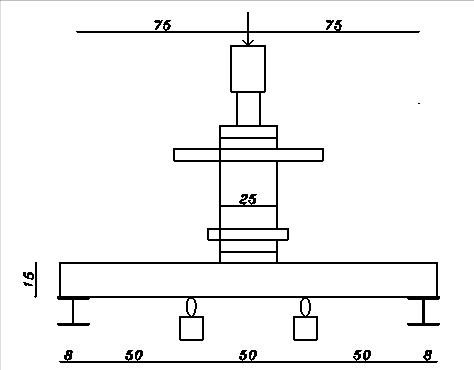
the Experimental Work
No Properties Description
1 Diameter (mm) 12
2 Weight per meter (g/m) 205
3 max load (KN) 119.7
4 Tensile strength (KN/mm2) 1057.98
5 Maximum strain .0275
Mixing is performed using a concrete drum mixer with maximum capacity 0.125 m3. Sand, aggregates and cement were dry mixed for about until a homogenous color.
Then the water was gradually added while mixing was continued for two minutes. The concrete was cast in the molds and cured at about 95% relative humidity.
The test was carried out in two stages. The first stage is that the sample is placed on the specialized device and the sample is exposed to fire as shown Fig. (3). Then the sample is left to cool in the air. Then the loading test is done by means of a hydraulic arm.
Fig 2: The furnace used in the fire
International Journal of Civil and Structural Engineering Research ISSN 2348-7607 (Online) Vol. 9, Issue 2, pp: (92-97), Month: October 2021 - March 2022, Available at: www.researchpublish.com
Digital Load cell of capacity of 550 kN with accuracy of 0.1 kN was adopted to measure the applied loads. The values of the applied loads were recorded from the monitor connected to the load cell. The slabs were tested using an incremental loading procedure. The vertical displacement of the tested beams was recorded using two electric dial gauges, one at the middle of slabs and the other at distance equal to one fourth lengths from the support. During tests.
III. TEST RESULTS AND ANALYSIS
In this part, the behavior RC slab with G-FRP exposed to fire under different conditions is analysis. Comparing between cracks patterns and load strain curves are discussion. The values of ultimate loads are analysis.
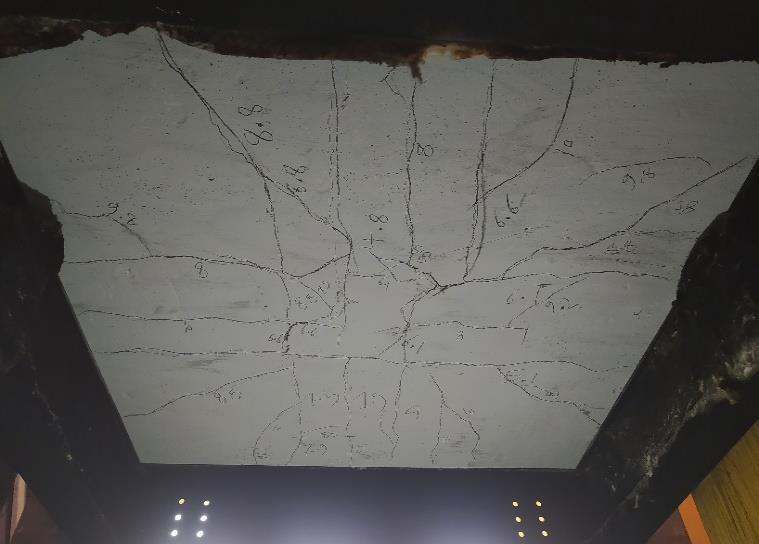
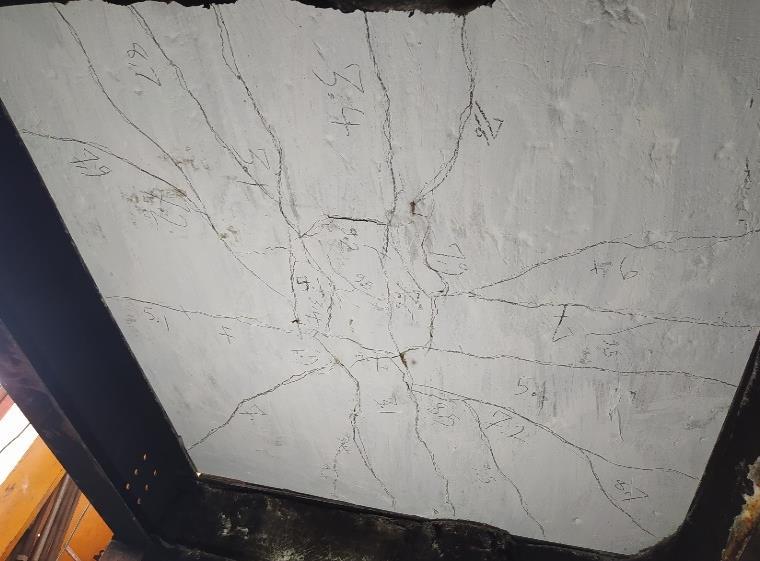
A. Crack Patterns and Modes of Failure
The crack pattern is as shown in Fig 4, where the shape of the collapse was clearly a piercing shear collapse, for each of the three samples. With the increase in the percentage of sea water in the sample, the number of cracks in the samples increased in the tension area where the fiber rods are located, and the high temperature was not effect on the shape of cracks, nor on the final collapse pattern.
Fig 3a (s1 – 0)
Fig 4b (s2- 50)
International Journal of Civil and Structural Engineering Research ISSN 2348-7607 (Online) Vol. 9, Issue 2, pp: (92-97), Month: October 2021 - March 2022, Available at: www.researchpublish.com
Fig 4c (s3 – 100)
B. Load strain Curved

The axial strains of the tension reinforcement were measured at specific points on the bottom mesh at different locations using electrical strain gages. The data was recorded using data acquisition system The typical locations of the strain gauges on the bottom reinforcement for the specimens, the vertical load was depicted against the axial strain for the specimen S1-0, S2-50, and S3-100 respectively as shown Fig 5 From the fig, the increase in the percentage of seawater and the temperature affects the properties of the fiber BARs and the way they work.
Fig 4a load-strain curve
Fig 5b load-strain curve

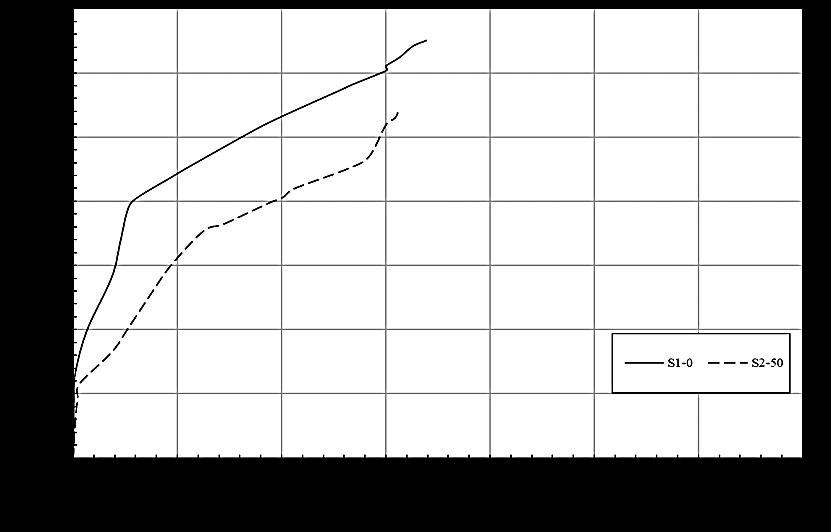
International Journal of Civil and Structural Engineering Research ISSN 2348-7607 (Online) Vol. 9, Issue 2, pp: (92-97), Month: October 2021 - March 2022, Available at: www.researchpublish.com
C. Tensile strength
A tensile test was conducted on the sample of the bars before exposure to seawater and fire. A sample of the fiber bars were extracted from the slabs and a tensile test was carried out on it, where an iron pipe was placed at both ends of the bar so that the tip of the bar would not collapse in the dismantling of the machine. As shown fig 6 After the fiber bars were exposed to fire and sea water, this led to a decrease in the tensile strength and a collapse form in the bar
Fig 5 tensile test
IV. CONCLUSIONS
Based on the analysis of the experimental results of fiber bars exposed to seawater and attic temperature, the following conclusions can be drawn:-
1-The effect of temperature on the bonding between the fiber bars and the concrete was noticeable by changing the shape of the fracture in some parts to be parallel to the reinforcing bars.
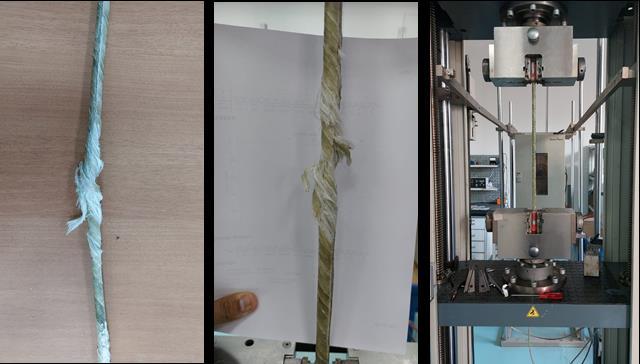
2-The exposure of the bars made of fiberglass to heat, and sea water led to a decrease in the tensile strength of the bars
3-The use of fiber bars with temperatures affects the amount of emotion that occurs to the bars
REFERENCES
[1] G. Li, J. Zhao, and Z. Wang, “Fatigue behavior of glass fiber-reinforced polymer bars after elevated temperatures exposure,” Materials (Basel)., vol. 11, no. 6, pp. 1–16, 2018, doi: 10.3390/ma11061028.
[2] M. Khatibmasjedi, S. Ramanathan, P. Suraneni, and A. Nanni, “Durability of Commercially Available GFRP Reinforcement in Seawater-Mixed Concrete under Accelerated Aging Conditions,” J. Compos. Constr., vol. 24, no. 4, p. 04020026, 2020, doi: 10.1061/(asce)cc.1943-5614.0001035.
[3] Abdelrahman A. E. Alsallamin, “Durability of Glass Fiber-Reinforced Polymer Bars in Seawater-Contaminated Concrete,” 2017.
[4] L. Wang, Y. Mao, H. Lv, S. Chen, and W. Li, “Bond properties between FRP bars and coral concrete under seawater conditions at 30, 60, and 80 °C,” Constr. Build. Mater., vol. 162, pp. 442–449, 2018, doi: 10.1016/j.conbuildmat. 2017.12.058.
[5] P. J. H. Abdolkarim Abbasi, “6 Temperature and environmental effects on glass fibre rebar modulus,.pdf.” 2005.
[6] H. Hajiloo and M. F. Green, “Bond Strength of GFRP Reinforcing Bars at High Temperatures with Implications for Performance in Fire,” J. Compos. Constr., vol. 22, no. 6, p. 04018055, 2018, doi: 10.1061/(asce)cc.1943-5614.000 0897.
